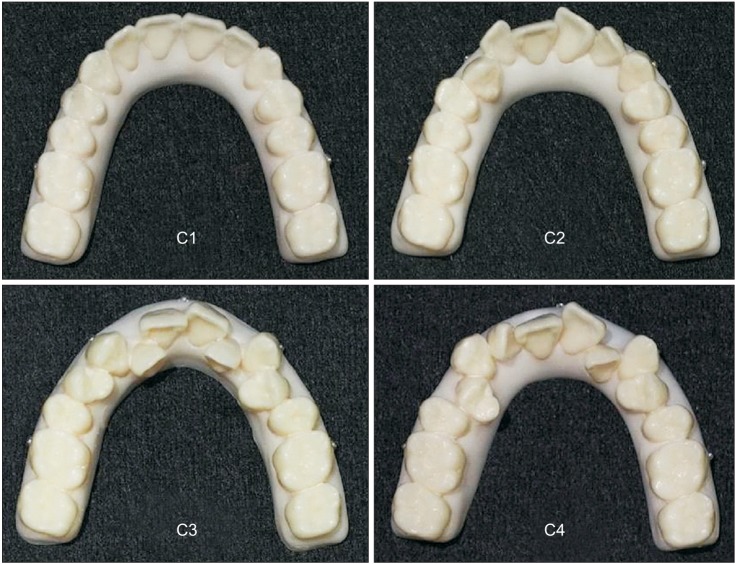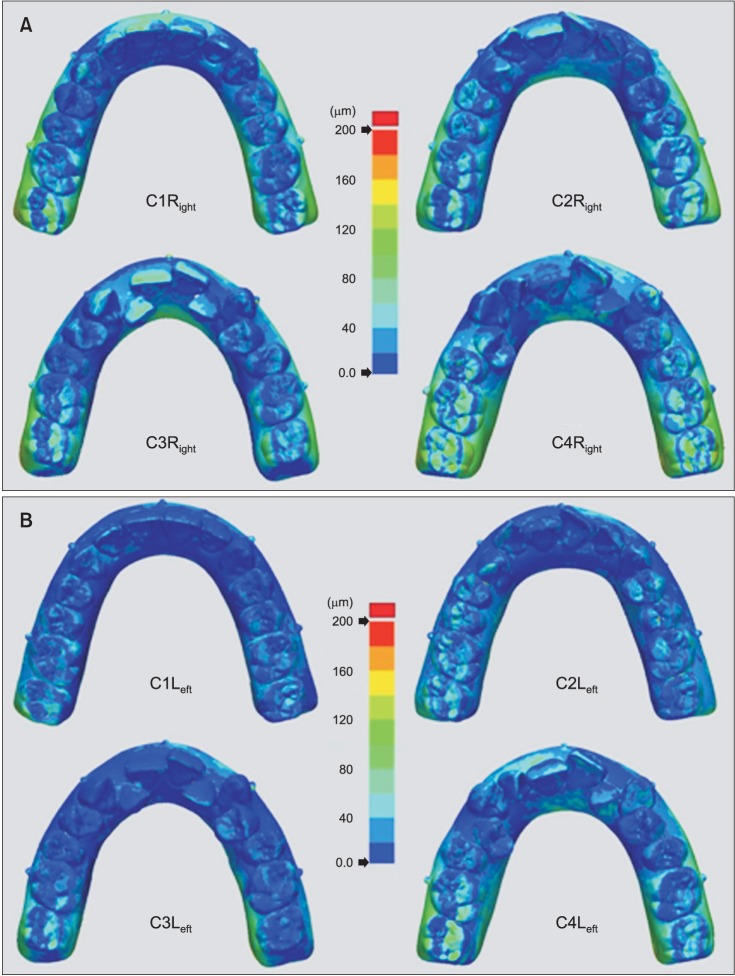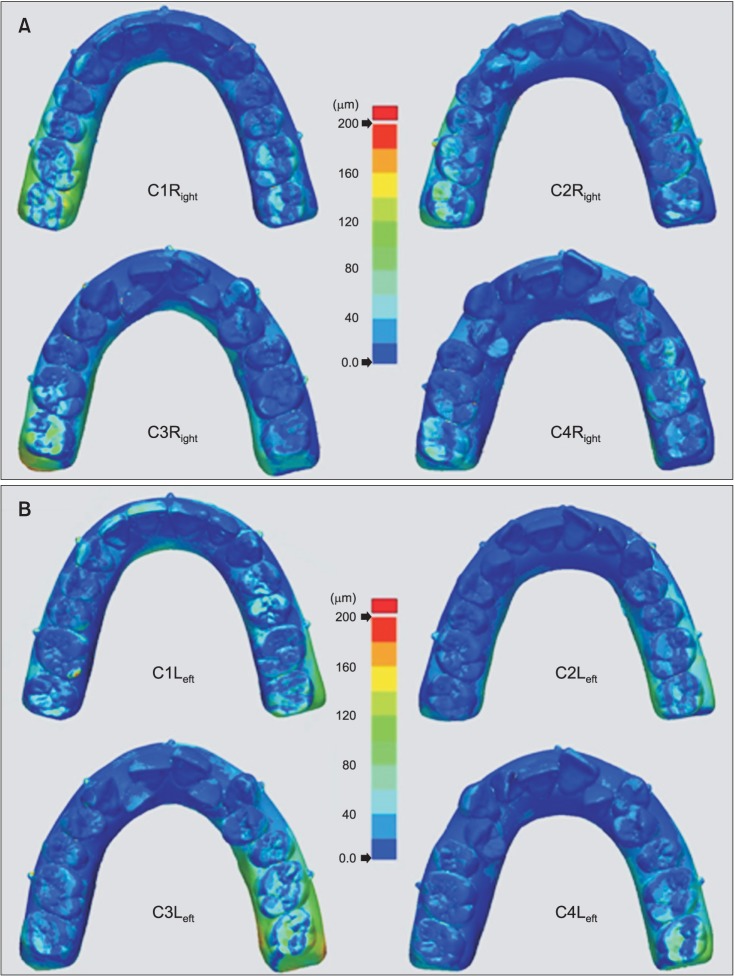Korean J Orthod.
2016 Jan;46(1):3-12. 10.4041/kjod.2016.46.1.3.
A comparison of the precision of three-dimensional images acquired by 2 digital intraoral scanners: effects of tooth irregularity and scanning direction
- Affiliations
-
- 1Department of Orthodontics, Graduate School of Clinical Dentistry, Ewha Womans University, Seoul, Korea. minjikim@ewha.ac.kr
- 2Department of Prosthodontics and Dental Research Institute, Seoul National University Gwanak Dental Hospital, Seoul, Korea.
- 3Department of Pediatric Dentistry, Graduate School of Clinical Dentistry, Ewha Womans University, Seoul, Korea.
- KMID: 2152892
- DOI: http://doi.org/10.4041/kjod.2016.46.1.3
Abstract
OBJECTIVE
The purpose of this study was to compare the precision of three-dimensional (3D) images acquired using iTero(R) (Align Technology Inc., San Jose, CA, USA) and Trios(R) (3Shape Dental Systems, Copenhagen, Denmark) digital intraoral scanners, and to evaluate the effects of the severity of tooth irregularities and scanning sequence on precision.
METHODS
Dental arch models were fabricated with differing degrees of tooth irregularity and divided into 2 groups based on scanning sequence. To assess their precision, images were superimposed and an optimized superimposition algorithm was employed to measure any 3D deviation. The t-test, paired t-test, and one-way ANOVA were performed (p < 0.05) for statistical analysis.
RESULTS
The iTero(R) and Trios(R) systems showed no statistically significant difference in precision among models with differing degrees of tooth irregularity. However, there were statistically significant differences in the precision of the 2 scanners when the starting points of scanning were different. The iTero(R) scanner (mean deviation, 29.84 +/- 12.08 microm) proved to be less precise than the Trios(R) scanner (22.17 +/- 4.47 microm).
CONCLUSIONS
The precision of 3D images differed according to the degree of tooth irregularity, scanning sequence, and scanner type. However, from a clinical standpoint, both scanners were highly accurate regardless of the degree of tooth irregularity.
Keyword
MeSH Terms
Figure
Cited by 3 articles
-
Clinical application of an intraoral scanner for serial evaluation of orthodontic tooth movement: A preliminary study
Dalsun Yun, Dong-Soon Choi, Insan Jang, Bong-Kuen Cha
Korean J Orthod. 2018;48(4):262-267. doi: 10.4041/kjod.2018.48.4.262.Comparison of patient satisfaction with digital and conventional impression for prosthodontic treatment
Hyung-In Yoon, Su-Min Lee, Eun-Jin Park
J Korean Acad Prosthodont. 2016;54(4):379-386. doi: 10.4047/jkap.2016.54.4.379.Evaluation of accuracy of 3-dimensional printed dental models in reproducing intermaxillary relational measurements: Based on inter-operator differences
Won-joon Choi, Su-jung Lee, Cheol-Hyun Moon
Korean J Orthod. 2022;52(1):20-28. doi: 10.4041/kjod.2022.52.1.20.
Reference
-
1. Mah J, Hatcher D. Current status and future needs in craniofacial imaging. Orthod Craniofac Res. 2003; 6(Suppl 1):10–16. PMID: 14606529.
Article2. White AJ, Fallis DW, Vandewalle KS. Analysis of intra-arch and interarch measurements from digital models with 2 impression materials and a modeling process based on cone-beam computed tomography. Am J Orthod Dentofacial Orthop. 2010; 137:456.e1–456.e9. PMID: 20362900.
Article3. Chandran DT, Jagger DC, Jagger RG, Barbour ME. Two- and three-dimensional accuracy of dental impression materials: effects of storage time and moisture contamination. Biomed Mater Eng. 2010; 20:243–249. PMID: 21084736.
Article4. Al Mortadi N, Eggbeer D, Lewis J, Williams RJ. CAD/CAM/AM applications in the manufacture of dental appliances. Am J Orthod Dentofacial Orthop. 2012; 142:727–733. PMID: 23116514.
Article5. Beuer F, Schweiger J, Edelhoff D. Digital dentistry: an overview of recent developments for CAD/CAM generated restorations. Br Dent J. 2008; 204:505–511. PMID: 18469768.
Article6. Cha BK, Lee JY, Jost-Brinkmann PG, Yoshida N. Analysis of tooth movement in extraction cases using three-dimensional reverse engineering technology. Eur J Orthod. 2007; 29:325–331. PMID: 17513876.
Article7. Hajeer MY, Millett DT, Ayoub AF, Siebert JP. Applications of 3D imaging in orthodontics: part II. J Orthod. 2004; 31:154–162. PMID: 15210932.8. Patel N. Integrating three-dimensional digital technologies for comprehensive implant dentistry. J Am Dent Assoc. 2010; 141(Suppl 2):20S–24S. PMID: 20516111.
Article9. Zhang XJ, He L, Guo HM, Tian J, Bai YX, Li S. Integrated three-dimensional digital assessment of accuracy of anterior tooth movement using clear aligners. Korean J Orthod. 2015; 45:275–281. PMID: 26629473.
Article10. Watanabe-Kanno GA, Abrão J, Miasiro Junior H, Sánchez-Ayala A, Lagravère MO. Reproducibility, reliability and validity of measurements obtained from Cecile3 digital models. Braz Oral Res. 2009; 23:288–295. PMID: 19893964.
Article11. Yourtee D, Emery J, Smith RE, Hodgson B. Stereolithographic models of biopolymers. J Mol Graph Model. 2000; 18:26–28. 59–60. PMID: 10935203.
Article12. Normung DDIf. Accuracy (trueness and precision) of measurement methods and results - Part 1: General principles and definitions (ISO 5725-1:1994). Berlin: Beuth Verlag GmbH;1997.13. Ender A, Mehl A. Accuracy of complete-arch dental impressions: a new method of measuring trueness and precision. J Prosthet Dent. 2013; 109:121–128. PMID: 23395338.
Article14. Flügge TV, Schlager S, Nelson K, Nahles S, Metzger MC. Precision of intraoral digital dental impressions with iTero and extraoral digitization with the iTero and a model scanner. Am J Orthod Dentofacial Orthop. 2013; 144:471–478. PMID: 23992820.
Article15. Wiranto MG, Engelbrecht WP, Tutein Nolthenius HE, van der Meer WJ, Ren Y. Validity, reliability, and reproducibility of linear measurements on digital models obtained from intraoral and cone-beam computed tomography scans of alginate impressions. Am J Orthod Dentofacial Orthop. 2013; 143:140–147. PMID: 23273370.
Article16. Naidu D, Freer TJ. Validity, reliability, and reproducibility of the iOC intraoral scanner: a comparison of tooth widths and Bolton ratios. Am J Orthod Dentofacial Orthop. 2013; 144:304–310. PMID: 23910212.
Article17. Patzelt SB, Emmanouilidi A, Stampf S, Strub JR, Att W. Accuracy of full-arch scans using intraoral scanners. Clin Oral Investig. 2014; 18:1687–1694.
Article18. Persson AS, Odén A, Andersson M, Sandborgh-Englund G. Digitization of simulated clinical dental impressions: virtual three-dimensional analysis of exactness. Dent Mater. 2009; 25:929–936. PMID: 19264353.
Article19. Mehl A, Ender A, Mörmann W, Attin T. Accuracy testing of a new intraoral 3D camera. Int J Comput Dent. 2009; 12:11–28. PMID: 19213357.20. Logozzo S, Zanetti EM, Franceschini G, Kilpelä A, Mäkynen A. Recent advances in dental optics-Part I: 3D intraoral scanners for restorative dentistry. Opt Laser Eng. 2014; 54:203–221.21. Kusnoto B, Evans CA. Reliability of a 3D surface laser scanner for orthodontic applications. Am J Orthod Dentofacial Orthop. 2002; 122:342–348. PMID: 12411877.
Article22. Ender A, Mehl A. Full arch scans: conventional versus digital impressions--an in-vitro study. Int J Comput Dent. 2011; 14:11–21. PMID: 21657122.23. Ender A, Mehl A. Influence of scanning strategies on the accuracy of digital intraoral scanning systems. Int J Comput Dent. 2013; 16:11–21. PMID: 23641661.
- Full Text Links
- Actions
-
Cited
- CITED
-
- Close
- Share
- Similar articles
-
- Comparative analysis on reproducibility among 5 intraoral scanners: sectional analysis according to restoration type and preparation outline form
- Full-arch accuracy of five intraoral scanners:In vivo analysis of trueness and precision
- Effect of scanning strategies on the accuracy of digital intraoral scanners: a meta-analysis of in vitro studies
- Comparison of intraoral scanning and conventional impression techniques using 3-dimensional superimposition
- Quantitative and qualitative evaluation on the accuracy of three intraoral scanners for human identification in forensic odontology





